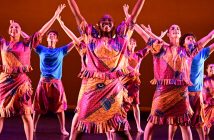That’s one analogy for describing China’s relationship with its sometimes-fraught modern history, said Yiju Huang, PhD. If the family members don’t talk about the trauma, “it will bubble up in some other forms and haunt their life,” Huang said. “On a societal and cultural level, I think it does the same thing.”
Huang—a professor of Chinese in the Department of Modern Languages and Literatures—studies how the art, film, and literature of contemporary China reflect the many disruptions in its national life in the modern era.
There have been quite a few, starting with the Opium Wars—a 19th-century clash with the West—and continuing through the Great Leap Forward, with its disastrous collectivization and famine that caused tens of millions of deaths; the Cultural Revolution of the 1960s and 70s; and the more recent shift toward market-friendly socialism.
Along the way, traditional belief systems like Confucianism have come under attack, often as “the culprit of China’s backwardness,” leading to a drastic sense of change that needs to be acknowledged and explored, she said.
“The fabric that used to tie the entire society together collapsed,” Huang said. “Modern Chinese history can really be seen as this continuous journey of finding that new fabric, that new thinking, while (trying) to eradicate the old thinking. Basically, you have this ongoing struggle of finding a new essence for Chinese identity and Chinese culture.”
That struggle was the topic of her first book, Tapestry of Light: Aesthetic Afterlives of the Cultural Revolution (Brill, 2014), an account of the revolution’s psychic, intellectual, and cultural echoes.
The Cultural Revolution was launched in 1966 by Chinese Communist Party Chairman Mao Zedong, who saw a need to restore Chinese communism via violent purges, persecutions, and a youth uprising against the party itself. It disrupted the economy, the school system, families, and traditional values and resulted in as many as 1.5 million deaths.
Hastily brought to a close in 1976, it was tagged by the still-ruling Chinese Communist Party as simply a mistake brought on by Mao, who was allegedly misguided by the “Gang of Four,” and the party abruptly turned its back on the revolution and focused instead on economic development, Huang said.
But disillusionment with the revolution lingers, as shown in the artistic works—films, family portraits, works of fiction—that she examines in Tapestry of Light, she said. They convey indeterminacy and trenchant loss—“not only in terms of human costs—that’s huge, and absolutely important—but also on an intellectual, political and theoretical level,” she said.
Huang objects to some attempts to draw lessons from the Cultural Revolution, arguing that it was a catastrophic event whose effects aren’t yet clear.
“I have to define it as catastrophic precisely because you have to work through the past thoroughly, particularly the massive crimes it indulged, before even attempting to think there is anything valuable that can be claimed from Maoist period,” she said.
This view is informed by her graduate school studies in trauma theories and psychoanalysis, with their emphasis on delving into a past trauma to resolve it. For her next book project, she wants to study Chinese modernity and the trajectory of China’s modern history from a new perspective. Rather than applying the Freudian approach of dwelling on a past loss and trying to repair the self, she wants to examine the ghostly aesthetics in literature inspired by China’s local religions, myths, fables and superstitions.
“For Eastern philosophical traditions, there’s a drastically different understanding of the cause of trauma and the nature of suffering,” she said. “For Freud, trauma occurs when the ego is unprepared and its virtual boundary is blasted open.”
Taoism, by contrast, sees trauma as caused by holding onto a static, unchanging notion of the self. “This is completely different from Freudian notion of trauma,” she said. “The Tao Te Ching states, ‘If I have no self, what calamity do I have?’ So one who values the self as the world can be given the world.”
She’ll incorporate stories of the supernatural, like the 2006 novel Life and Death are Wearing Me Out (Arcade, 2006). Written by the Chinese author Mo Yan, it describes the ghost of a landowner executed by the government in 1948 who experiences China’s seminal political events over the next decade after being reincarnated as various animals, and then eventually as human again.
“The ghost story is a favored metaphor for Chinese authors to work through history,” she said. “It’s a locus of abundant possibilities. It’s full of ambiguities, echoes, memories, and future hopes. Through the metaphor of transmigration, this beautiful linkage is built among different individual beings, among different forms of lives,” reflecting an empathic view that contrasts with trauma theory’s focus on the negative and reified past, she said.
“It’s a poetic of opening out, instead of digging into a closed corner,” she said.
Chinese history could use such a view, given what has prevailed in the past, like Mao Zedong’s belief that humans must conquer nature, she said.
“This great faith in science and industrialization is actually anti-scientific because it’s not self-questioning,” she said. “Modernity is quite violent in its linear overdetermined trajectory.”
“But ghosts articulate multiple possibilities of different routes, different paths of how history can develop, or should develop, or how the future should look.”



